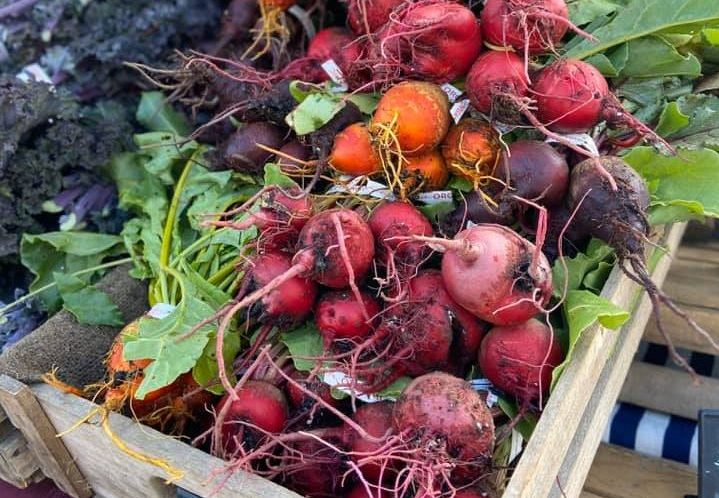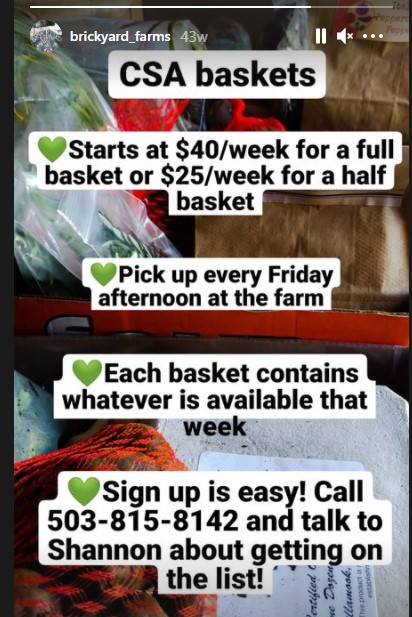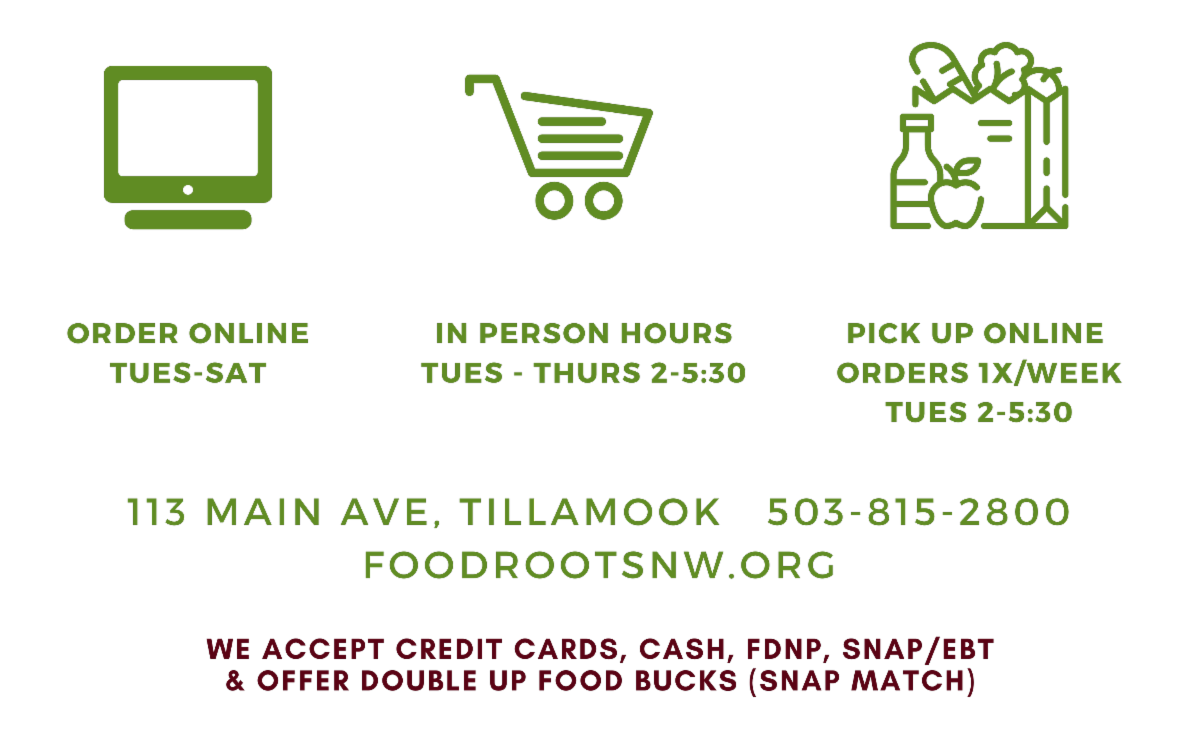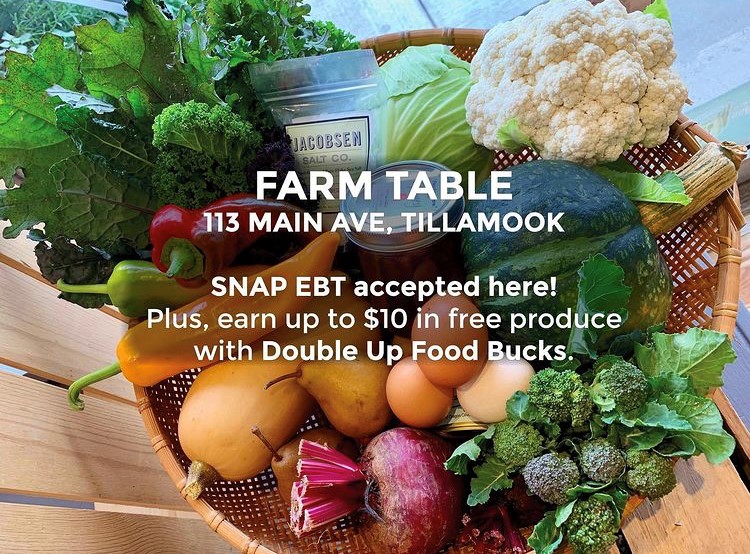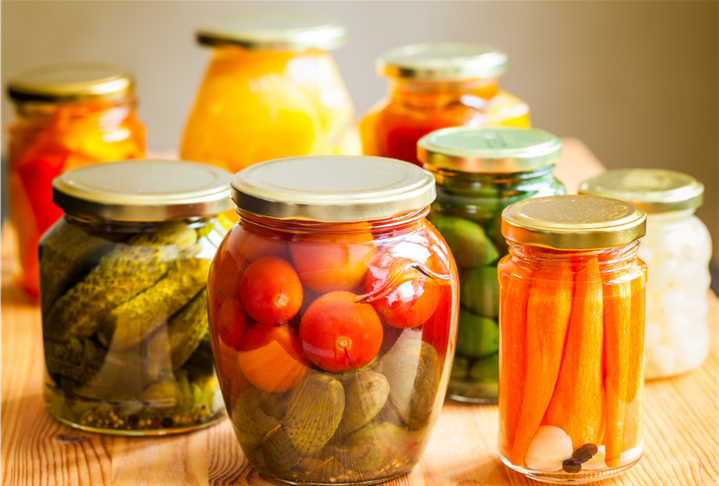
by Guest | Aug 18, 2021 | Eat Well
‘Tis the season of garden bounties. From tangled plants with large ripe squash to towering tomato plants studded with fruit, this time of year always seems to produce more than one can keep up with. With a bit of time and some prep, you can preserve your summer’s bounty so that it lasts all year long without going to waste. Here are a few of our favorite ways to preserve the fruit of our labor for months on end:
Freeze!
Simple as that. Most produce from your garden can be prepped and kept in your freezer. Some fruits and veggies do best blanched prior to being frozen like peaches, rhubarb, or tomatoes. This helps maintain the flavor, color, and texture. Fruits like apples and pears do best sliced before being frozen, and berries, even cherries, do best stored in the freezer as whole.
Pickle
When you think of pickles, you often think of the green crunchy slices that top your burger or sandwich, but any fruit or vegetable can be pickled. Some tasty and unexpected pickled items include carrots, zucchini and even blueberries and peaches. If you’re in a rush, you can also quick pickle items with some vinegar and salt which lengthens their shelf just a tad.
Can
If you have the right equipment, canning is an excellent way to preserve the life of your summer crops. Our friends at the OSU Extension Services are hosting a Canning Pickles, Tomatoes and Salsa workshop on Thursday, August 26 and Saturday, August 28 for those looking for a lesson. The course costs $15. More details and the sign up can be found on their website here.
Freezer Jam
Freezer jam is the easier version of jam-making and doesn’t require sterilizing jars and equipment. Typically made with fruit, sugar, water, and pectin, freezer jam is quick and easy to make and yields delicious results that you can enjoy on toast or share with friends (it makes a great gift!).
Sauce It
You can make all sorts of delicious sauces that can be stored for long periods of time. A garden tomato sauce or marinara is delicious in the colder winter months and can be frozen, or if canned, stored in a cool dark place. Apple sauce is another great staple to have around for months and allows you to enjoy your fruit all year long.
Helpful Resources:
4 Easy Ways to Preserve Fruit & Vegetables at Home | The Old Farmer’s Almanac
General Tips for Freezing Fresh Produce and Meat | Better Homes & Gardens (bhg.com)
Pickled Fruit – Waves in the Kitchen
AUTHOR: Elizabeth Parker, Tillamook Creamery Marketing, Communications, and Brand Manager
For more local health and wellness information, follow Tillamook County Wellness on Facebook, Instagram and Twitter.

by Guest | May 26, 2021 | Eat Well, Move Well
(Photo Credit: Tillamook Chamber of Commerce)
In and around Tillamook County we have an abundance of small farms and producers offering everything from farm fresh eggs to artisan cheeses, preservatives, roasted coffee, and of course – fruits and vegetables. As farmers market season approaches, it’s easier than ever to support local farmers and makers while also buying fresh, sustainable food items grown right here in Tillamook County.
Tillamook County is home to four farmers markets spreading from Neskowin to Manzanita that are in operation from mid-May to October. That means that no matter where you live, there is a market near you offering a healthy alternative to shopping at the grocery store. At each of these markets you will find locally-grown produce and other food items that are fresher and often less expensive than what you can get in stores. And, many of the markets offer shopping incentives for SNAP customers, making it more affordable and convenient to buy high-quality food for their families.
In 2020, each of the farmers markets in the county had to overcome several hurdles due to the pandemic that included location changes, interruptions in services, and even limitations on vendors and the number of shoppers allowed. As the state begins to reopen, the markets are once again planning in-person events with more updates and changes for 2021.
Neskowin Farmers Market
The Neskowin Farmers Market underwent massive changes in 2020 that required them to move to Neskowin Valley School for the season, and limit their vendors to grocery items only. This year, they are moving again – this time to a more permanent location at the Proposals Art Center, located at the corner of HWY 101 and Summit Road across the highway from the Neskowin Beach Wayside. With this new location comes not only a stunning backdrop, but also private parking for market patrons and room to grow and expand.
The Neskowin Farmers Market opened May 22 and runs through October 2 – making it the longest season of all the Tillamook County farmers markets. You can find them every Saturday from 9 a.m. – 1 p.m. This year their vendor line up includes not only grocery items such as fresh fruits and vegetables, pastured meats, local cheeses, canned goods, and bakery items, but also fresh flowers and plants, wood-fire pizza, fiber arts, photography, jewelry and other arts and crafts. Live music will also be making a comeback.
Pacific City Farmers Market
The only Sunday Market in the county, the Pacific City Farmers Market opens June 13th and runs through Sept. 26th from 10 a.m. to 2 p.m. This quaint market is located in the parking lot of the Pacific City Library at 6000 Camp Street on the corner of Brooten Road. You’ll find fresh fruits and vegetables, honey, cheese, eggs, handcrafted soaps, jewelry, homemade pottery and delicious baked goods. If you prefer a more intimate shopping experience with less of a crowd then this is a perfect market to visit.
Tillamook Farmers Market
The Tillamook Farmers Market opens June 12th and operates every Saturday from 9 a.m. – 2 p.m. until Sept. 25th. The market is located on the corner of Laurel Avenue and Second Street; directly in front of the Tillamook County Courthouse.
This season you can expect to find live music, kids games, activities and more of the vibrant ambiance that you’ve come to expect, and which was sadly missing in 2020. You will also find a wide array of vendors selling everything from outdoor furniture, homemade rugs and pottery, honey, preservatives, farm-raised meat, cheeses, microgreens, fruits and vegetables, fresh-cut flowers, roasted coffee, nursery trees, and arts and crafts. Towards the end of the season, you can stock up on canned and frozen seafood from several local fishermen offered at discount prices when you buy in bulk.
The Tillamook Farmers Market accepts SNAP payments from customers with an EBT Card, and is enrolled in the Double Up Food Bucks Program (DUFB). That means SNAP customers who spend up to $10 at the Market can receive a $10 DUFB match for additional fruits and vegetables. Customers can only receive the match once per day, however the DUFB dollars can be spent at any market in the state that accepts them. Certain vendors can also accept Farm Direct Nutrition Program checks.
Manzanita Farmers Market
The Manzanita Farmers Market opens Friday, June 11th at 4 p.m at the Underhill Plaza in Manzanita (635 Manzanita Ave.). This is a brand new location for the Manzanita Farmers Market, which was forced to move in 2020 to the Rex Champ Ball Field due to COVID restrictions. They will be holding an in-person market this year, unlike the drive-through style they started the season with in 2020.
Their new location, which is on the corner of Manzanita Ave and Division Street, is slated to become the new Manzanita City Hall. At just about 1.5 acres, the new space is nearly three times the size of their previous location on S. 5th Street, which allows the market to host a full complement of vendors even under the strictest distancing regulations. So far they have about 45 vendors, making it the largest market in the county and also the only evening market.
With plenty of room to grow, the market now has the potential to accommodate up to 80 vendors at one time – once all COVID restrictions are lifted, of course.
The Manzanita Market also accepts SNAP and Double Up Food Bucks, and certain vendors can accept Farm Direct Nutrition Program checks as payment.
AUTHOR: Sayde Walker, Content Creation Specialist
For more local health and wellness information, follow Tillamook County Wellness on Facebook, Instagram and Twitter.

by Guest | Mar 24, 2021 | Being Well, Eat Well
Pharmacy or Farmacy?
Food has become much more complicated than it once was. Instead of simple ingredients going into homemade foods, we have an abundance of time-saving products that may have a more enticing taste and may also be a cheaper way to get a filling meal on the table. Is it worth it to save time with convenient foods? Which convenient foods aren’t as nourishing? Are these foods helping us toward our desire to feel good and enjoy our health?
In comes the concept of food as medicine. Food is nature’s medicine, providing our body with the building blocks that it needs to maintain health. Some say that we can pay a farmer now, or a pharmacy later. And while this statement may oversimplify the whole picture of nutrition and health, hopefully it has you thinking. In reading the ideas below, you may draw some connections between what is (or isn’t) on your fork and how you’re feeling.
Note: If you decide to take a food as medicine approach to eating, it is important to continue to take medications as prescribed and consult with your medical provider before making any medication changes. A salad with dinner is not a replacement for a specific medication, though several small steps over time may begin to shift things in a positive direction.
Food informs our bodies
Food is a powerful source of information for our bodies and we have several opportunities each day to make choices about what food we will eat. The field of epigenetics looks at how behaviors and environment can affect the expression of our genes. For someone with a family history of a particular condition or disease, there may be nutrition and lifestyle factors that can alter gene expression in a way that protects from that condition or disease. While we don’t need to strive for perfection with our food choices or become fearful of eating something that isn’t seen as nutritious, there are many ways we can adjust our food choices to be supportive of our health. Whether you already have a health-related diagnosis or are focused on prevention, there are many ways you can start making changes to move toward your goals.
Food connects us to the land
As the ground continues to warm and more seeds begin stirring within the earth, there will be more and more signs of spring here on the North Coast. This area is home to many amazing growers and producers, each offering us a unique way to connect with our region and with the seasons. While most of us enjoy the variety that we can find at a grocery store, nature is also providing what we need throughout the year. For example, vitamin C comes from many more places than oranges! In the early spring we may find vitamin C in overwintered kale in the garden, in the summer in fresh, juicy strawberries that come from the valley an in the winter in potatoes from a local farm.
Eating plants is for everyone
Luckily, you don’t need to claim to be a vegetarian or vegan to enjoy a wide variety of fruits and vegetables with your meals – plant foods are for everyone! Our bodies benefit from plants in various ways, such as the fiber that many plant foods contain. Fiber can bring ease to digestion, feeds the beneficial bacteria that live in our digestive tracts and can be an important part of a meal feeling satisfying. When increasing the amount of plant foods in your daily meals, it can also be a good idea to drink enough water, as water and fiber work together to keep digestion moving smoothly.
Boost flavor and nutrition with herbs and spices
Herbs and spices can be great ways to get an extra dose of nutrition and flavor. Many herbs and spices are sources of antioxidants, which are often linked to protecting the health of our cells. Adding spices could be as simple as a dash of ground pepper or more of a focus like a soup spiced with curry powder. Herbs can be used as a garnish, such as a sprinkle of parsley on the top of a bowl of soup or as a main feature of the meal such as vegetables and pasta tossed with basil pesto.
Eating well on a budget
If using food as medicine sounds expensive, it doesn’t have to be! There are many ways to prepare and eat nutritious foods on a budget. Beans and lentils provide protein, fiber and so much more and are a great base for a hearty meal. If you don’t have access to fresh vegetables or they often go bad in your refrigerator, frozen and canned can also be great options. Several local farms have Community Supported Agriculture (CSA) boxes that you can subscribe to in the spring and enjoy a box of fresh vegetables each week throughout the summer. Buying spices in bulk can be much less expensive and allows you to try smaller amounts of new spices to see if you like them before purchasing a larger quantity.
Finding what works for you
If using a food as medicine philosophy is something you’re interested in and you’re not sure where to begin, you may want to connect with your primary care provider and ask for a referral to meet with a registered dietitian. Registered dietitians are trained to translate nutrition science into actionable steps that you can take to maintain your health and to help treat or prevent many common illnesses. With some creativity and a sense of adventure, making changes to support your health and how you feel can be a fun and rewarding experiment.
For more information:
Community Supported Agriculture (CSAs): Food Roots provides a pickup spot for weekly CSAs and also has a wonderful selection of local products throughout the year; accepts SNAP benefits and matching program also available https://www.foodrootsnw.org/csa-shares
Meet with a Registered Dietitian: Tillamook County Community Health Centers (503-842-3900 https://tillamookchc.org/) and Adventist Health (503-842-4444 https://www.adventisthealth.org/tillamook/) both offer appointments with registered dietitians
Epigenetics: https://www.cdc.gov/genomics/disease/epigenetics.htm
Food Hero: for some fun and tasty recipes from OSU Extension Service, visit https://www.foodhero.org/
AUTHOR: Erica Johnson, Registered Dietitian at Tillamook County Community Health Center
For more local health and wellness information, follow Tillamook County Wellness on Facebook, Instagram and Twitter.

by Guest | Feb 23, 2021 | Being Well, Eat Well
March is National Nutrition Month and an easy way to focus on healthy eating is by choosing locally-sourced foods. Tillamook County residents have a variety of options when it comes to enjoying the bounty of local foods available literally from our own backyards. Gardening has seen a resurgence in popularity during the pandemic, and there are several sources for FREE seeds available at the main branch of the Tillamook Library. Call Sarah Beeler for more information about acquiring seeds at 503-842-4792 ext.1708. Food Roots will also be distributing seeds to EVERY kindergarten through 6th grader in Tillamook County.
If growing your own isn’t an option, consider signing up for a local CSA (Community-Support Agriculture) subscription box. This is a great deal and makes your veggie purchases easy throughout the growing season. Beginning in May or June depending on the farm, CSA subscribers receive a box (or set amount – half shares are often available) of seasonal produce. Generally, a full-share CSA provides enough, or usually more than enough, produce for a family of four, and often half shares are available as well. The CSA boxes also often come with recipes and ideas for the veggies, and include heirloom varieties and provide an opportunity to experiment and try lots of vegetables.
According to Corvus Landing Farm, “Your CSA share is truly an investment in the farm. Your early season payments have allowed us to buy seed, supplies, and invest in improvements to the farm. It is a huge motivator to know that there are folks ready and waiting to feast on the delicious returns! Thank you from the bottom of our hearts!”
For more information, contact the Farms directly for subscription information, amounts, costs, drop-off/pick-up/delivery and more:
Brickyard Farms
brickyard_farms@outlook.com
503-815-8142
Available “grown-at-the-coast” and tested for success in our Coastal environments – tomato and pepper starts available.
Watch for the list of tomato and pepper varieties – Email to be on the list to reserve your starts now – available mid-May.
Kingfisher Farms
503-888-3196 (Jeff Trenary)
20 weeks beginning in May
Moss Creek Family Farm
503-300-0085
Message on Facebook
Food Roots: 113 Main Ave Tillamook OR, 503-815-2800, https://www.foodrootsnw.org/
SNAP/EBT Payments for CSA Shares: Food Roots accepts SNAP payments for CSA Shares on behalf of their partnering farms. In addition, they provide SNAP customers with Double Up Food Bucks to reduce the overall cost of the CSA share, further increasing the affordability of local food. There are flexible purchasing options, please ask.
Register for your CSA Directly with Farms: Please note that this year registration for all CSA shares (including SNAP CSAs) will occur directly with farms. Please contact the farms above to choose and register for a share plan that works best for you. Some farms are in the process of setting up their CSA programs, so signup for their wait lists and be patient.
Farm Table Storefront: Meanwhile, until CSA’s begin, you can satisfy your appetite for local foods with Food Roots “Farm Table” storefront that features a wide variety of local producers including in-season vegetables, cheeses, eggs, honey and more! There are multiple ways to shop the Farm Table. You can order online here for pick up on Tuesdays between 2 and 5:30 pm. Or shop in person Tuesday, Wednesday or Thursday from 2 to 5:30 pm.
Pay it Forward with SNAP Match Donations: Food Roots offers a 2:1 match on SNAP dollars spent at FarmTable. This match can be used on all SNAP-eligible food items. Spend $1 with EBT payment, receive $2 free.
Interested in helping your neighbors purchase fresh food while supporting our region’s farmers and food producers? Just add “Support our SNAP Match Program!” to your cart with your next purchase. These funds are utilized as matching funds when customers shop with their EBT (food benefit) card.
New Delivery Service: Food Roots is gearing up for another launch this spring 2021, a new food delivery service available to FarmTable customers throughout Tillamook County and in partnership with North Coast Food Web of Clatsop County. Stay tuned for more details to come! The purchase of this new delivery vehicle was made possible thanks to Columbia Pacific Coordinated Care Organization, Tillamook County’s COVID-19 Relief Fund and Oregon Coast Visitors Association.
There are also local farm produce stands available with seasonal produce:
- Josi Farms (formerly DeNoble’s Produce Stand) at 735 Wilson River Loop, Tillamook – self-serve farm stand
- Valley Fresh Produce at 5112 Third St., Tillamook
- HomeGrown at Kendra’s River Inn, 34910 Hwy. 53 at Miami Foley Rd., Mohler
And, remember, starting in June local Farmers Markets will be opening as well – Manzanita Farmers Market on Fridays; Neskowin and Tillamook on Saturdays; and Pacific City on Sundays. Watch for more information about Farmers Market openings soon!
You can make every month “nutrition month” by eating locally-grown foods that provides so many benefits to mind, body, soul and community. When you buy from a local producer, you are not only feeding your family, you are helping to feed many local families.
AUTHOR: Laura Swanson, TCW Advisory Committee Member and Tillamook County Pioneer Editor
For more local health and wellness information, follow Tillamook County Wellness on Facebook, Instagram and Twitter.
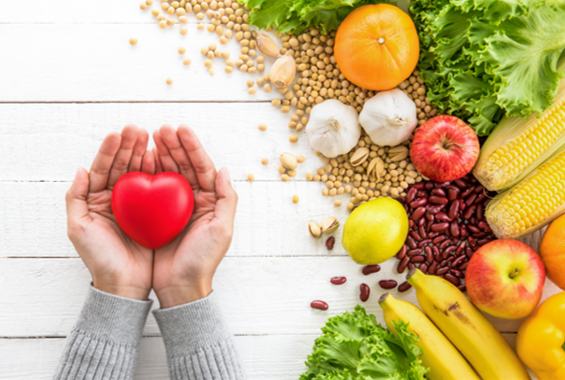
by Guest | Feb 10, 2021 | Being Well, Eat Well
What does pleasant hunger feel like to you? This can be a hard question to answer! Pleasure and hunger don’t always seem to belong in the same sentence. Unpleasant hunger makes more sense. “Hanger” and the negative emotions associated with a feeling of “starvation” come to mind right away. Luckily, hunger can be pleasant if it is realized early on and leads to intentional planning of when and what you eat.
Pleasant hunger is thinking to yourself “I think I’m ready for a meal/snack” and allowing yourself to consider what’s available, sounds satisfying and meets your health goals. You sit down to eat and find yourself savoring your food. This is a pleasurable feeling! On the other hand, let’s say you ignored that initial hunger cue. Time passes, you start to feel impatient and anxious, maybe you have a headache or feel shaky. You’ve reached a point where you don’t care what you eat, you just. need. to. eat! You scarf down whatever is within reach, not paying attention to how it tastes, how much you eat or if it’s truly satisfying. While you might feel relieved afterwards, wouldn’t you rather have enjoyed the complete eating experience?
Enjoying your eating experience is a concept of intuitive eating, or mindful eating. It encourages listening to your body’s cues about hunger and food. It’s also sometimes called the “anti-diet approach” because it takes the rigidity out of eating we see with dieting. Mindful eating frees you from the “dos and don’ts” of eating that a culture of fad diets attempts to instill in us. Mindful eaters have more body appreciation, they enjoy eating, and they experience fewer disordered eating behaviors like intentionally skipping meals, yo-yo dieting, and feelings of guilt and shame around food. Mindful eaters also tend to be more food budget conscious- something we can all appreciate!
Below are the 10 principles of intuitive eating, developed by Evelyn Tribole and Elyse Resch. (https://www.intuitiveeating.org/) Remember, these principles are guidelines, not rules. Food and rules are like oil and water; they just don’t blend.
- Reject the Diet Mentality – Has living in a culture that promotes fad diets distorted your thoughts about yourself? Has it impacted your social life, opinions about food, or your personal relationships? Try redirecting your time and energy into something meaningful that brings you joy.
- Honor Your Hunger – How do you handle your other bodily cues, like a full bladder? When you feel the need, you use the restroom without following “rules” or questioning if you “deserve” it. Try approaching hunger in the same, ordinary manner. Eat when you really are hungry or find an alternative activity (read, dance, listen to music, etc.) if you’re actually bored, emotional or looking for a distraction. Consistent and accurate honoring of hunger cues heals and rebuilds connection with your body.
- Make Peace with Food – While traditional food fights (the kind that involve messes) are fun, the battle between food “rules” and your needs or wants is anything but fun. Try taking a bite and then ask yourself: how does this food taste?
- Challenge the Food Police – The food police enforce those unreasonable rules that diet culture has created. Remember, food and rules don’t belong together. Work with a Registered Dietitian Nutritionist who can help you find healthy eating style that works for you.
- Discover the Satisfaction Factor Explore your food, especially taste, texture and aroma. Does it bring back any memories? How does it make you feel? Satisfaction in eating comes from within.
- Feel Your Fullness We’ve explored pleasant hunger; how would you imagine or describe how pleasant fullness feels?
- Cope with Your Emotions with Kindness While food is comforting, it can’t solve our problems. Consider writing down how you’re feeling, making a pros-and-cons list, or calling a friend. Explore actions that might offer you some clarity.
- Respect Your Body How awesome is it that you have your very own, one-of-a-kind genetic blueprint? Nobody is like you! So, is it fair to compare your body to another body, or judge your food preferences or cravings against those of others?
- Movement- Feel the Difference Can you reflect on a time, perhaps as a child, when you looked forward to physical activity? What has changed, and how can you rebuild that positive relationship?
- Honor Your Health- Gentle Nutrition Healthy eating looks different for everyone- there is not a perfect formula. Try making food choices that honor your health and preferences while also making you feel good.
After practicing intuitive eating ideas for a while, you might find yourself going for a walk because you want to, not because you “have to.” Maybe you’ll try your hand at art, pick up a fun book, or try a new yoga class. Practicing intuitive eating can help you honor your needs -social, emotional, cultural, physical, etc.- and find pleasure in truly nourishing yourself. Hopefully these ideas bring peace to your meals and snacks!
AUTHOR: Katlyn Wolf, Oregon State Dietetic Intern, future Registered Dietitian
For more local health and wellness information, follow Tillamook County Wellness on Facebook, Instagram and Twitter.

by Guest | Nov 19, 2020 | Eat Well, Recipes

Judy Barbe was a featured speaker for the Tillamook County “Year of Wellness” in 2016.
With the holidays in full swing, I am the Ghost of Christmas Practical.
Yes, I’m baking cookies and pies. I mean, it really wouldn’t be a celebration without them, would it? But I’m trying to keep a handle on sugar.
Holiday weight gain
Most of us can use a hand reducing extra calories this time of year. The latest research (
https://www.livescience.com/56206-holiday-weight-gain-america-japan-germany.html) indicates that many of us gain just less than two pounds during the holidays. Two pounds. That’s not much.
The good news is that half of us will lose most of the weight, but the other half will still be carrying the extra pounds in summer. Two pounds every year for ten years? Maybe that explains where that extra weight came from…Christmas 2006!
A healthy pumpkin pie recipe
That’s why I am excited about this pie. I reduced the sugar by half from a traditional recipe and the only one who will know it is the baker.
Gingersnap Pumpkin Pie = easy pumpkin pie
Piecrusts can be the enemy of pie bakers, but this crust takes the cake on easy. I use store-bought gingersnaps to make the crust. These spicy little cookies don’t need added sugar and there is no rolling pin required.
The filling is spiced up, the sugar is toned down and the topper is a dollop of honey-flavored Greek yogurt. The yogurt provides tanginess to the spicy pie and crust. All in all, a fork-worthy pie. The healthier pumpkin pie could even be breakfast!
Holiday health tips
I’m not sure I’ve ever seen a sugarplum, let alone one dance around my head, but with all the temptations during the next few weeks, this pie is a delicious and practical solution. Here are a few more holiday helpers:
- Fill up on fiber. Every 10-gram increase in daily fiber reduces hunger and belly fat. Make oatmeal or bulgur your breakfast. Include an apple or pear for lunch. Add beans to soups, salads and stews.
- Go to bed. Sleeping 6-7 hours per night helps maintain regular weight.
- Move your feet. Physical activity burns calories and reduces stress. Consider a walk your mental filter for the holidays.
- Feed your soul. Feeling grateful, volunteering, and laughing with friends boosts your mood and sense of well-being.
P.S. Hungry for more healthy living tips and recipes? Sign up for my newsletter at https://landing.mailerlite.com/webforms/landing/v1q9c9
Lower Sugar Gingersnap Pumpkin Pie
Gingersnap Pumpkin Pie, with half the sugar from a traditional recipe, is a healthier pumpkin pie. And the only one who will know it is the baker! Top it with honey yogurt rather than whipped cream for even more calorie savings.
- Author: Judy Barbe
- Prep Time: 20 mins
- Cook Time: 1 hour
- Total Time: 1 hour 20 minutes
- Yield: 8
Ingredients:
Crust:
- 20 gingersnaps, 2 1/4-inch diameter cookies
- 2 tablespoons melted butter
Pumpkin pie filling:
- 1/2 cup sugar
- 1 teaspoon cinnamon
- 1/2 teaspoon ground ginger
- 1/4 teaspoon ground cloves
- 1/4 teaspoon salt
- 2 eggs
- 1 tablespoon vanilla
- 1 15-ounce can pumpkin
- 1 12-ounce can evaporated milk
- Honey flavored Greek-style yogurt
Instructions:
- Heat oven to 350 degrees.
- To make crust: Break gingersnaps in half. Process in food processor, pulsing 6-7 times until coarse crumbs. Pour in melted butter. Process 5-6 times until butter is incorporated and mixture looks sandy.
- Press crumbs into 9-inch pie plate. Use the back of a spoon or custard cup to press crumbs firmly into pie plate. Bake 8 minutes. Remove from oven to cool.
- To make pumpkin pie filling:
- Heat oven to 375 degrees.
- In a small bowl stir together sugar, cinnamon, ginger, cloves and salt. Set aside.
- In large mixing bowl or stand mixer, beat eggs and vanilla to blend. Add spices and pumpkin to egg mixture, combine thoroughly. Slowly pour in evaporated milk and stir gently until mixture is uniform consistency.
- Pour filling into crust. You may have some leftover filling. Place in 375 degree oven and bake 45-50 minutes. The filling should be set but may have a slight jiggle when you move the pie plate. Internal temperature of pumpkin pie filling should be 165 degrees.
- Bake the leftover filling in a custard cup to enjoy later.
- To serve, spoon on a dollop of honey flavored Greek-style yogurt.
Recipe source: Judy Barbe, www.LiveBest.info
Judy Barbe is a registered dietitian, speaker, and author of Your 6-Week Guide to LiveBest: Simple Solutions for Fresh Food & Well-Being. Visit her website
http://www.LiveBest.info for every day food solutions. What are you waiting for?
For more local health and wellness information, follow Tillamook County Wellness on Facebook, Instagram and Twitter.





